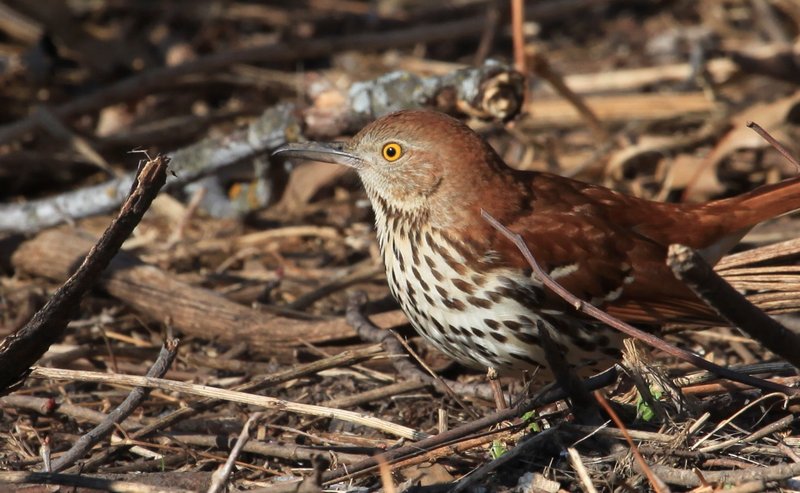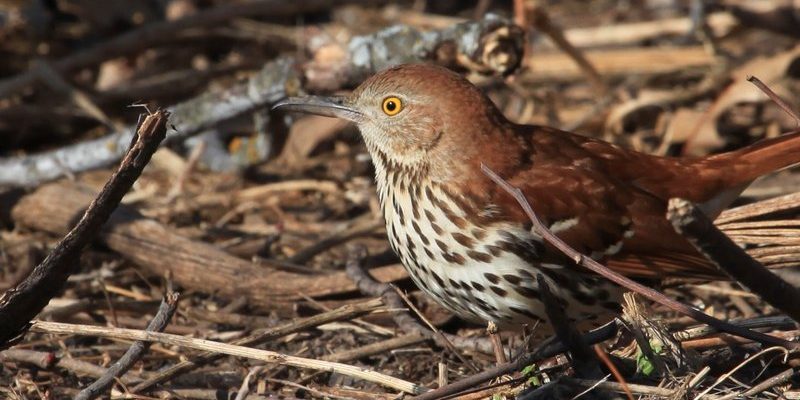
When you think of a backyard bird flitting around the trees, the Brown Thrasher might not be the first one that comes to mind. But trust me, this bird is a true gem. With its bright songs and striking appearance, the Brown Thrasher is not just another feathered friend—it’s a talented musician of the avian world. Imagine a bird that can sing over a thousand different songs, each with its own flair. Fascinating, isn’t it?
As you step into the world of the Brown Thrasher, you’ll discover more than just its impressive vocal talents. This bird is an intriguing mix of beauty and behavior, making it a favorite among birdwatchers and nature enthusiasts alike. From its sandy-brown feathers to its long tail, the Brown Thrasher has a lot to offer. So, let’s dive deeper into its world, exploring everything from its habitat to its unique habits.
Physical Characteristics
The Brown Thrasher is a medium-sized bird, measuring about 9 to 11 inches in length. To put that in perspective, it’s roughly the size of a robin, but with distinct features that make it stand out. Its upperparts are a warm, earthy brown, and it has a lovely spotted chest that gives it a stylish touch. The long, curved tail and hefty beak are signature traits, making it easily recognizable in the wild.
One of the most captivating features of the Brown Thrasher is its eyes. Large and round, they give the bird a curious and alert expression, perfect for spotting insects or potential predators in its surroundings. Its legs are relatively long, allowing for agile movements as it hops around looking for food. Simply put, this bird is not only functional but also quite the looker!
The plumage of a Brown Thrasher helps it blend into its natural environment, which consists mostly of shrubby areas and woodland edges. This camouflaging is a clever survival tactic, allowing it to avoid predators while it forages for food. Add to that its ability to mimic other birds and even mechanical sounds, and you’ve got a bird that’s not just pretty to look at, but also a master of disguise.
Habitat and Distribution
Brown Thrashers are most commonly found across North America, especially in the eastern and central parts of the continent. They prefer habitats that offer plenty of shrubs, thickets, and low trees. You might spot them in fields, urban parks, and even along the edges of forests. These birds thrive in environments where they can easily find insects and berries, which make up a big part of their diet.
What’s interesting is that Brown Thrashers are quite adaptable. They can adjust to various habitats as long as there’s enough ground cover for them to forage. You might even see them in gardens, where they rummage through leaf litter or scratch around flower beds. This flexibility in choosing their home helps them thrive in changing landscapes.
During migration, Brown Thrashers can travel long distances, moving south for the winter to warmer climates in the southeastern United States and parts of Mexico. This seasonal journey is fascinating, as it showcases their ability to navigate and find suitable habitats across vast distances. So, if you’re in their path, keep an eye out for these beautiful birds when spring arrives!
Diet and Feeding Habits
The Brown Thrasher has a varied diet, which makes it an opportunistic feeder. They primarily feast on insects, such as beetles, caterpillars, and grasshoppers, providing them with much-needed protein. But their palate doesn’t stop there. They also enjoy fruits, seeds, and berries, especially during the fall when nature offers a cornucopia of treats.
You might be wondering how they find their food. These birds use their keen eyesight and sharp ears to spot and listen for insects hidden under leaves or in the grass. Their strong, curved bills are perfectly designed to dig into the ground as they search for tasty morsels. Watching them foraging can be quite the spectacle, as they hop and scratch around, often using their legs to kick up leaves to expose hidden snacks.
Interestingly, Brown Thrashers have been observed using their beaks in creative ways. They might flip over objects like stones or twigs to uncover hidden insects or seeds. This kind of behavior showcases their intelligence and adaptability, traits that help them survive and thrive in varied environments. Talk about being resourceful!
Breeding and Nesting Behavior
When it comes to breeding, the Brown Thrasher has a unique courtship display. Males are known for their elaborate songs, which they use to attract females and establish territory. These songs are not just beautiful; they’re essential for communication and mating success. The male will often sing from a high perch, showcasing his vocal prowess and drawing the attention of potential mates.
Nesting typically occurs between late March and early July. The female takes on the primary role of building the nest, which is usually a well-hidden structure made of twigs, grass, and leaves. You can find these nests in dense bushes or low trees, providing safety from predators. After laying about 3 to 6 eggs, she’ll incubate them for about 12 to 14 days.
Once the chicks hatch, both parents play an active role in feeding and protecting them. You can often hear the frantic calls of baby thrashers as they demand food from their parents. This period is crucial for the young birds, as they learn essential survival skills before leaving the nest. After about two weeks, the fledglings are ready to take their first flights, starting their journey toward independence.
Behavior and Vocalizations
The Brown Thrasher is known for its stunning vocal abilities. With a repertoire of over a thousand distinct songs, it’s no wonder bird lovers are captivated by these creatures. Their calls can range from melodic to harsh and screechy, often imitating other birds and sounds in their environment. This mimicry not only showcases their talent but also serves various purposes, such as warning off intruders or attracting mates.
You might catch a Brown Thrasher singing joyfully in the early morning or late afternoon, filling the air with music. The songs can be quite complex, featuring different patterns and rhythms, making each performance unique. This rich musicality is part of what makes them special in the birding community and why they often leave a lasting impression on those who hear them.
Aside from their songs, Brown Thrashers are naturally curious and energetic birds. They often engage in playful behaviors, such as chasing each other or hopping around in search of food. Observing these antics can be a delightful experience, as they showcase their lively personalities. When you’ve got a Brown Thrasher around, you can be sure there’s never a dull moment!
Conservation Status
Currently, the Brown Thrasher is considered a species of low concern by conservation organizations, thanks to its wide distribution and adaptability. However, like many other birds, they face challenges that could potentially impact their populations. Habitat loss, mainly due to urban development and agricultural changes, poses a significant threat to their natural habitats.
While they are not in immediate danger, it’s essential to keep an eye on populations and protect their habitats. In areas where proper nesting sites and food sources are diminished, Brown Thrasher populations can decline. Participating in bird conservation efforts and creating bird-friendly spaces in your garden can help support these beautiful creatures.
Organizations like the Audubon Society and local wildlife organizations often work towards habitat conservation and awareness campaigns to protect birds like the Brown Thrasher. By learning about these initiatives and getting involved, you can play a part in ensuring that future generations get to enjoy the melodies of this charming bird.
Interesting Facts
| Size: | 9 to 11 inches in length |
| Wingspan: | 12 to 14 inches |
| Weight: | 2.5 to 3.5 ounces |
| Diet: | Insects, fruits, seeds |
| Song Variety: | Over 1,000 different songs |
| Habitat: | Woodlands, shrubs, urban parks |
| Migration: | Southern migration for winter |
FAQ
What is the Brown Thrasher’s lifespan?
The Brown Thrasher can live for several years in the wild, typically ranging from 2 to 5 years. However, some individuals have been known to live significantly longer, with reports of birds reaching up to 10 years old. Lifespan can be influenced by various factors, including predation and environmental conditions.
Are Brown Thrashers migratory birds?
Yes, Brown Thrashers are migratory birds. They primarily breed in the northern regions of North America and migrate southward to warmer climates for the winter months. This seasonal movement typically occurs from late September to early November, and they return to their breeding grounds in early spring.
Do Brown Thrashers mate for life?
While Brown Thrashers don’t mate for life, they do form monogamous pairs during the breeding season. Once the nesting period is over, these pairs may separate, with males seeking new mates in the following season. However, they often return to the same general areas for breeding year after year.
What do Brown Thrashers sound like?
Brown Thrashers are known for their beautiful, varied songs. They can mimic the calls of other birds and sounds from their environment. Their songs can be described as rich, melodic, and sometimes even complex, filled with different patterns and variations. Birdwatchers often enjoy listening to their performances in the early mornings or late afternoons.
How can I attract Brown Thrashers to my yard?
To attract Brown Thrashers to your yard, consider creating a bird-friendly habitat. They are drawn to shrubby areas, so planting native shrubs and bushes can provide cover and food sources. Offering a birdbath for drinking and bathing can also be appealing. Additionally, leaving leaf litter or mulched areas can help them find insects to forage.
Are Brown Thrashers social birds?
Brown Thrashers are generally solitary or found in pairs, especially during the breeding season. However, in the winter months, they may congregate in loose groups. While they are not highly social birds, they do tolerate others of their species when foraging or roosting in suitable habitats.
What challenges do Brown Thrashers face?
Brown Thrashers face challenges primarily related to habitat loss due to urban development, agricultural changes, and deforestation. These factors can lead to a decrease in suitable nesting sites and food availability. Additionally, predation, especially by domestic cats, poses a significant risk to their populations.

